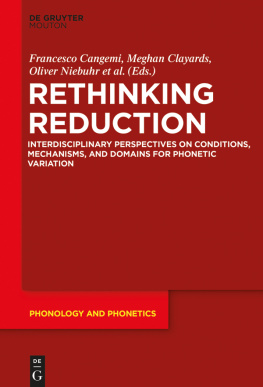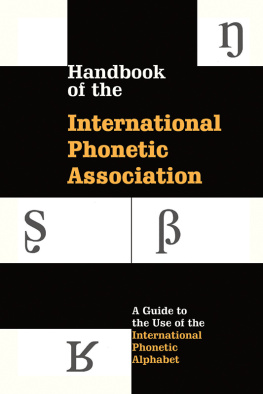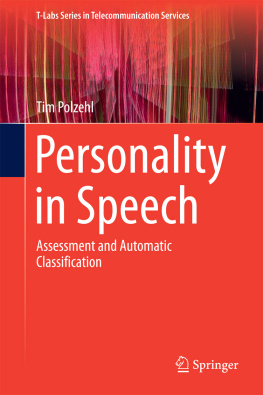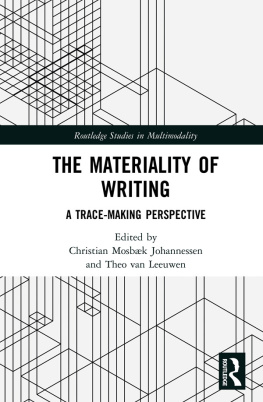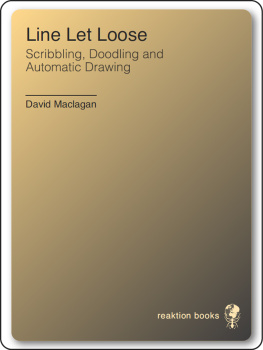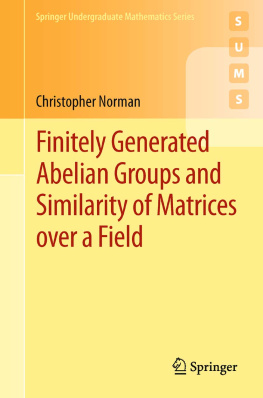Contents
Guide

Francesco Cangemi, Meghan Clayards, Oliver Niebuhr,
Barbara Schuppler and Margaret Zellers (Eds.)
Rethinking Reduction
Phonology and Phonetics

Editor
Aditi Lahiri
Volume 25

ISBN 978-3-11-052163-4
e-ISBN (PDF) 978-3-11-052417-8
e-ISBN (EPUB) 978-3-11-052171-9
ISSN 1861-4191
Library of Congress Control Number: 2018934238
Bibliografische Information der Deutschen Nationalbibliothek
The Deutsche Nationalbibliothek lists this publication in the Deutschen Nationalbibliografie; detailed bibliographic data are available on the Internet http://dnb.dnb.de.
2018 Walter de Gruyter GmbH, Berlin/Boston
www.degruyter.com
Preface
This book began as a result of a reunion workshop for members of Sound to Sense (S2S), an EU-funded Marie Curie Research Training Network (MC-RTN) that ran from 2007 to 2011. Engineers, computer scientists, psychologists, and linguistic phoneticians worked together to explore new ideas about how humans understand speech, and how scientists can use this knowledge to improve the way we communicate with each other and with machines. We used a variety of approaches to investigate what types of information are available in the speech signal, and how listeners use that information when they are listening in their native language, or in a foreign language, or in a noisy place like a railway station when it is hard to hear the speech. These three types of listening situation allow us to see how listeners actively use their pre-existing knowledge, together with the speech they hear, to understand a message.
The workshop leading to this book was held in Kiel in 2012, after S2Ss funding period was over. Most PhD students on the grant had graduated and, like the postdoctoral students, moved on to employment around Europe. Twenty original S2S members attended the workshop, along with 10 people who had not been members. I unfortunately could not attend the workshop, but was asked to write this preface in my capacity as Coordinator of S2S. In particular, I was tasked with describing S2S and assessing how well the current book reflects the values and aims of S2S.
The books title indeed reflects both the focus of the workshop and a major focus of S2S: how to observe, analyze, and describe the changes that words undergo when they are produced in meaningful connected speech, especially spontaneous speech, compared with in isolation; to what extent those changes help or hinder listeners to understand the meaning of utterances that is, whether, and if so how, listeners exploit those changes to aid understanding; and to what extent the conclusions of such research point to a need to change standard cognitive-linguistic theories and approaches to applications such as users of foreign languages and automatic speech recognition by machines.
Within these general research areas, the chapters vary considerably, for example, in the type of speech studied (e.g. read, spontaneous conversational, careful, and fast), the range of languages and regional varieties (it would be good to extend further to non-European languages), the units of analysis (acoustic features, articulatory trajectories, phones, syllables, words, phrases), the types of measurement and methods (see style, and several comparisons across languages. The typical approach is broadly enquiring, open-minded, yet critical, be it about general cognitive processes, or units of analysis such as syllables and phones. This breadth of approach yet attention to phonetic detail likewise reflects the spirit of S2S during its lifetime.
Another positive aspect of S2S was its inclusivity. The consortium began with quite a large membership, and grew bigger as it went on. Moreover, especially in the second half of its lifetime, when research questions and working patterns were fairly well established, it was our practice to broaden our horizons by inviting non-members to speak at our regular workshops. The contributors to this book very much reflect this spirit of outward-looking collaboration. A total of 21 authors have contributed to the 9 chapters. Eleven individuals who were either members of S2S or contributed invited talks and/ or technical skills have contributed to six of the ) are authored by 10 individuals who had no connection with S2S in its lifetime. The majority of the latter group work in North America, which tended to be excluded de facto from major EU funding. It is good to see North American as well as new European work represented in this book.
The five editors of the book, all former S2S fellows, have written helpful and thoughtful bookends to the other chapters which go beyond general orientation to the main contents of the book. first provides a historical perspective about this complex subject and then draws together conclusions from the various contributions as part of looking to the future. These chapters together remove any need for me to say more about the books contents.
So I could stop right here. But instead, since some self-indulgence is acceptable in a preface, I would like to add a personal viewpoint. As this book makes clear, the term reduction in linguistics is historically predicated on the idea that there is something not quite right or normal about it that citation-form pronunciations are to be preferred because they transmit more information. Yet, as far as we know, the phenomena of reduction are integral to effective communication in every language and subject to interacting processes of every type that affects effective speech communication in its broadest sense. So rather than emphasizing the meaning of reduction as of taking something away from a preferred version, we might get further by defining it in terms of another of its many meanings, that of essence . The strong hypothesis would be that reduced forms provide the phonetic essence that allows effective communication in the particular circumstances under consideration. This hypothesis is probably too strong, but may prove accurate if we develop models sophisticated and broad enough to take account of all the particular circumstances, which must include the utterances function, and each interlocutors beliefs about what the others involved in the interaction understand and this should certainly be our aim. More achievable at the present time might be to adopt a simple concept of essence. A good analogy may be that of reduction in cooking. When one reduces a sauce, one decreases its volume, but that is not the point. The real aim is to add properties that cannot be achieved without the process of reduction: at its best, an exquisite blending of the critical attributes of the ingredients that is intense in itself, and enhances the experience of the food it accompanies, yet bears such indirect resemblance to the original ingredients that only experts (be it chefs or native speakers) can recover what those unreduced ingredients must have been. Yet everyone, expert and novice alike, can eat and appreciate the reduced sauce without necessarily knowing how it relates to other manifestations of its ingredients.
In conclusion, I believe I speak for all the contributors in saying that my hope for this book is that it will help to refocus thinking about speech production and perception. Our field could benefit from greater sensitivity in acknowledging complexity, multiple influences, and context-dependency rather than contrasting single properties or pitting theories against each other in a narrow either-or approach. For example, debates about contrast versus gradience may become more nuanced when gradience is conceptualized as the consequence of multiple influences interacting on a sound pattern to different degrees, and perhaps for different reasons. Recognition of complexity may allow us to develop more realistic models. But we are not there yet. Most work on reduction processes is still at the descriptive stage, and it is proving hard to move beyond that. Gathering rich descriptions together is valuable, however, for if we can describe the complexity well, then underlying explanatory principles should be more easily discerned; indeed, as in many areas of biological sciences, explanation may turn out to be relatively simple once the right level of analysis is identified. But we are currently very far from reaching that depth of understanding. Rather, we are still at the stage of widening and redefining our fields of enquiry to include recognition that there is much more to the transmission of spoken information than that conveyed by syllables divorced from meaning, or by meaningful words spoken in isolation, and that only by adopting such broader perspectives will we be able to account for what in the past has been dismissed as inexplicable and probably irrelevant variation. This book is a welcome step toward that goal.

